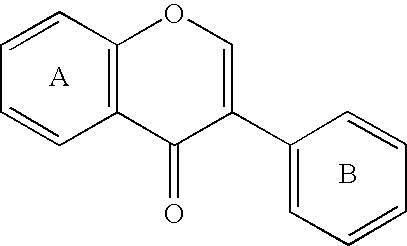Flavonoid concentrates
a technology of flavonoid concentrates and concentrates, which is applied in the field of flavonoid concentrates, can solve the problems of complex multi-step processing, inability to recover raw materials isoflavones, and inability to meet the needs of consumption, and achieves simple and convenient methods. , the effect of higher levels and yield
- Summary
- Abstract
- Description
- Claims
- Application Information
AI Technical Summary
Benefits of technology
Problems solved by technology
Method used
Image
Examples
example 1
Production of Isoflavonoid Enriched Concentrates from Sprouted Albus Lupines
[0074] Bitter White Italian Lupines (Lupinus albus), provisionally identified as Tasmanian grown Superlupe cultivar, average seed weight 0.7 g, were soaked for 24 hours with two 1 hour air breaks and then soaked for approximately 1 hour every 12 hours thereafter.
[0075] The lupines were exposed to low intensity indirect sunlight and allowed to sprout at a room temperature of approximately 20 to 25° C., care being taken to separate off decaying non-viable seeds and keep a low stack height. On the twelfth day when the roots were well developed with some cotyledons opened up almost completely and primary leaves opening out, the sprouts were processed in a blender. 56 sprouts free from any attached hulls, weighing 191 grams, were divided into two batches and blended with an equal weight of water for 3 minutes.
[0076] After allowing 30 minutes from the finish of the second blending for the enzymatic hydrolysis o...
example 2
Production of Isoflavonoid Enriched Concentrates from Sprouted Albus Lupines, with a Heating Step to Increase Protein Retention
[0080] Bitter White Italian Lupines (Lupinus albus), provisionally identified as Tasmanian grown Superlupe cultivar were soaked for 24 hours with two 1 hour air breaks and then soaked for approximately 1 hour every 12 hours thereafter. Care was taken to separate the germinating seeds from the non-viable seeds and to ensure that the individual seeds had plenty of germination room.
[0081] The lupines were exposed to low intensity indirect sunlight and allowed to sprout at a room temperature of approximately 20 to 25° C. and on the twelfth day when the roots were well developed with some cotyledons opened up almost completely and primary leaves opening out, the sprouts were processed in a kitchen blender. 56 sprouts freed from any attached hulls weighting 182 grams, were divided into two batches and blended with an equal weight of water for four minutes.
[0082...
example 3
Production of Isoflavonoid Enriched Concentrates from Sprouted Albus Lupines, After Storage at a Low Temperature, with a Heating Step to Increase Protein Retention
[0088] Bitter White Italian Lupines (Lupinus albus), provisionally identified as Tasmanian grown Superlupe cultivar were soaked for 24 hours with two 1 hour air breaks and then soaked for approximately 1 hour every 12 hours thereafter. Care was taken to separate the germinating seeds from the non-viable seeds and to ensure that the individual seeds had plenty of germination room.
[0089] The lupines were exposed to low intensity indirect sunlight and allowed to sprout at a room temperature of approximately 20 to 25° C. and on the twelfth day when the roots were well developed with some cotyledons opened up almost completely and primary leaves opening out, the sprouts were placed in moist soaked paper lined containers and stored at 6° C. for eight days.
[0090] After the temperature was allowed to adjust to room temperature ...
PUM
| Property | Measurement | Unit |
|---|---|---|
| pKa | aaaaa | aaaaa |
| pH | aaaaa | aaaaa |
| temperature | aaaaa | aaaaa |
Abstract
Description
Claims
Application Information
 Login to View More
Login to View More - R&D
- Intellectual Property
- Life Sciences
- Materials
- Tech Scout
- Unparalleled Data Quality
- Higher Quality Content
- 60% Fewer Hallucinations
Browse by: Latest US Patents, China's latest patents, Technical Efficacy Thesaurus, Application Domain, Technology Topic, Popular Technical Reports.
© 2025 PatSnap. All rights reserved.Legal|Privacy policy|Modern Slavery Act Transparency Statement|Sitemap|About US| Contact US: help@patsnap.com


